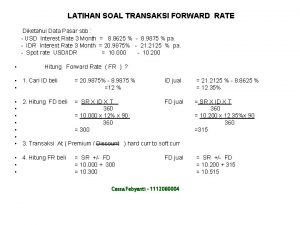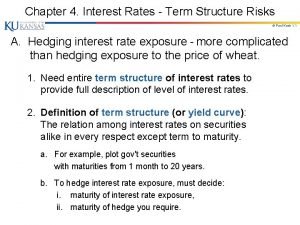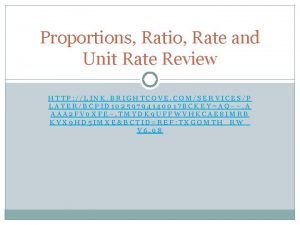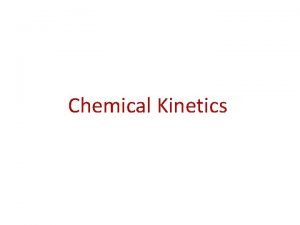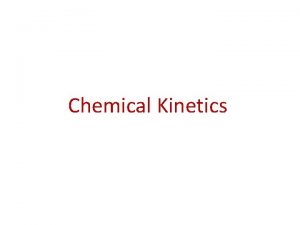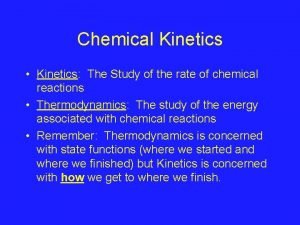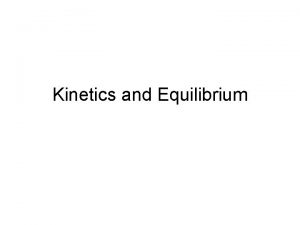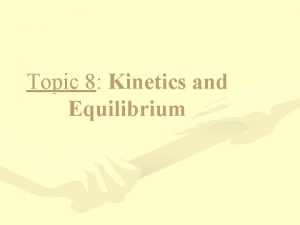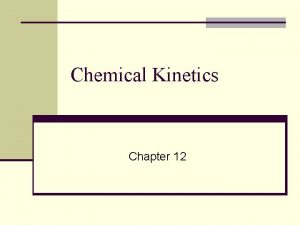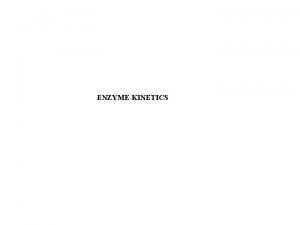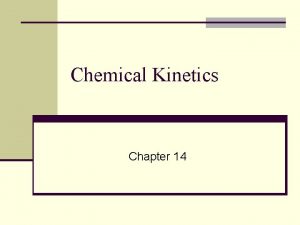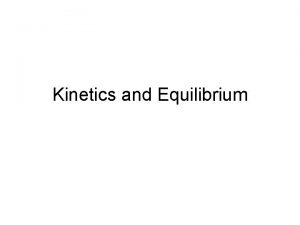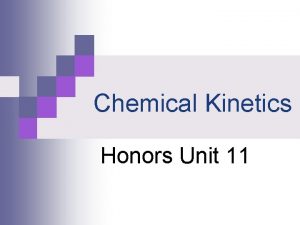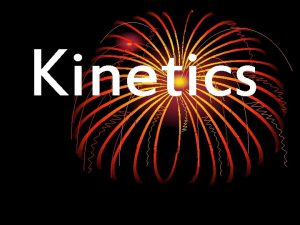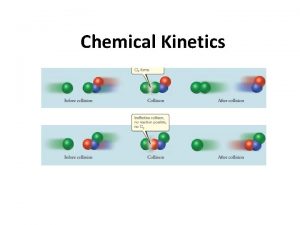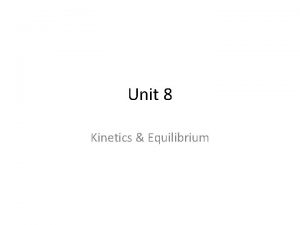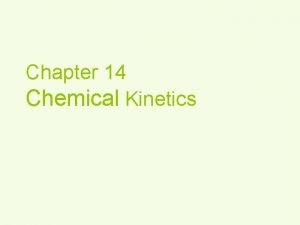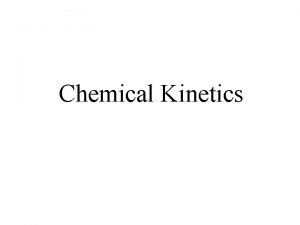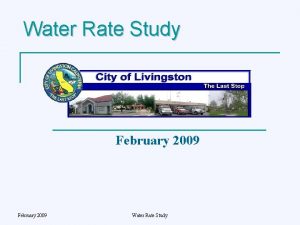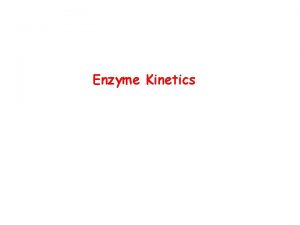Kinetics Kinetics In kinetics we study the rate



















![Rate Laws Rate = k [NH 4 +] − [NO 2 ] • The Rate Laws Rate = k [NH 4 +] − [NO 2 ] • The](https://slidetodoc.com/presentation_image_h/dd47f0764686d69689f6e2596d4855a3/image-20.jpg)
- Slides: 20

Kinetics

Kinetics • In kinetics we study the rate at which a chemical process occurs. • Besides information about the speed at which reactions occur, kinetics also sheds light on the reaction mechanism (exactly how the reaction occurs).

Factors That Affect Reaction Rates • Physical State of the Reactants – In order to react, molecules must come in contact with each other. – The more homogeneous the mixture of reactants, the faster the molecules can react.

Factors That Affect Reaction Rates • Temperature – At higher temperatures, reactant molecules have more kinetic energy, move faster, and collide more often and with greater energy.

Factors That Affect Reaction Rates • Presence of a Catalyst – Catalysts speed up reactions by changing the mechanism of the reaction. – Catalysts are not consumed during the course of the reaction.

Factors That Affect Reaction Rates • Concentration of Reactants – As the concentration of reactants increases, so does the likelihood that reactant molecules will collide.

Reaction Rates of reactions can be determined by monitoring the change in concentration of either reactants or products as a function of time.

Reaction Rates C 4 H 9 Cl(aq) + H 2 O(l) C 4 H 9 OH(aq) + HCl(aq) In this reaction, the concentration of butyl chloride, C 4 H 9 Cl, was measured at various times.

Reaction Rates C 4 H 9 Cl(aq) + H 2 O(l) C 4 H 9 OH(aq) + HCl(aq) The average rate of the reaction over each interval is the change in concentration divided by the change in time: [C 4 H 9 Cl] Average rate = t

Reaction Rates C 4 H 9 Cl(aq) + H 2 O(l) C 4 H 9 OH(aq) + HCl(aq) • Note that the average rate decreases as the reaction proceeds. • This is because as the reaction goes forward, there are fewer collisions between reactant molecules.

Reaction Rates C 4 H 9 Cl(aq) + H 2 O(l) C 4 H 9 OH(aq) + HCl(aq) • A plot of [C 4 H 9 Cl] vs. time for this reaction yields a curve like this. • The slope of a line tangent to the curve at any point is the instantaneous rate at that time.

Reaction Rates C 4 H 9 Cl(aq) + H 2 O(l) C 4 H 9 OH(aq) + HCl(aq) • All reactions slow down over time. • Therefore, the best indicator of the rate of a reaction is the instantaneous rate near the beginning of the reaction.

Reaction Rates and Stoichiometry C 4 H 9 Cl(aq) + H 2 O(l) C 4 H 9 OH(aq) + HCl(aq) • In this reaction, the ratio of C 4 H 9 Cl to C 4 H 9 OH is 1: 1. • Thus, the rate of disappearance of C 4 H 9 Cl is the same as the rate of appearance of C 4 H 9 OH. Rate = - [C 4 H 9 Cl] = t [C 4 H 9 OH] t

Reaction Rates and Stoichiometry • What if the ratio is not 1: 1? 2 HI(g) H 22(g) + I 22(g)

Reaction Rates and Stoichiometry • What if the ratio is not 1: 1? • To generalize, then, for the reaction a. A + b. B c. C + d. D 1 [A] 1 [B] 1 [C] 1 [D] =− = = Rate = − a b t c t d t t

Concentration and Rate One can gain information about the rate of a reaction by seeing how the rate changes with changes in concentration.

Concentration and Rate NH 4+(aq) + NO 2−(aq) N 2(g) + 2 H 2 O(l) If we compare Experiments 1 and 2, we see that when [NH 4+] doubles, the initial rate doubles.

Concentration and Rate NH 4+(aq) + NO 2−(aq) N 2(g) + 2 H 2 O(l) Likewise, when we compare Experiments 5 and 6, we see that when [NO 2−] doubles, the initial rate doubles.

Rate Laws • A rate law shows the relationship between the reaction rate and the concentrations of reactants. • The exponents tell the order of the reaction with respect to each reactant. • Since the rate law is Rate = k [NH 4+] [NO 2−] the reaction is First-order in [NH 4+] and − First-order in [NO 2 ].
![Rate Laws Rate k NH 4 NO 2 The Rate Laws Rate = k [NH 4 +] − [NO 2 ] • The](https://slidetodoc.com/presentation_image_h/dd47f0764686d69689f6e2596d4855a3/image-20.jpg)
Rate Laws Rate = k [NH 4 +] − [NO 2 ] • The overall reaction order can be found by adding the exponents on the reactants in the rate law. • This reaction is second-order overall.
 Cap rate interest rate relationship
Cap rate interest rate relationship What is real interest rate and nominal interest rate
What is real interest rate and nominal interest rate Growth analysis definition
Growth analysis definition Transaksi forward
Transaksi forward Determination of exchange rate
Determination of exchange rate 1 year forward rate formula
1 year forward rate formula 1 year forward rate formula
1 year forward rate formula Difference between rate and unit rate
Difference between rate and unit rate Hát kết hợp bộ gõ cơ thể
Hát kết hợp bộ gõ cơ thể Ng-html
Ng-html Bổ thể
Bổ thể Tỉ lệ cơ thể trẻ em
Tỉ lệ cơ thể trẻ em Chó sói
Chó sói Chụp phim tư thế worms-breton
Chụp phim tư thế worms-breton Alleluia hat len nguoi oi
Alleluia hat len nguoi oi Kể tên các môn thể thao
Kể tên các môn thể thao Thế nào là hệ số cao nhất
Thế nào là hệ số cao nhất Các châu lục và đại dương trên thế giới
Các châu lục và đại dương trên thế giới Công thức tính thế năng
Công thức tính thế năng Trời xanh đây là của chúng ta thể thơ
Trời xanh đây là của chúng ta thể thơ Mật thư anh em như thể tay chân
Mật thư anh em như thể tay chân



